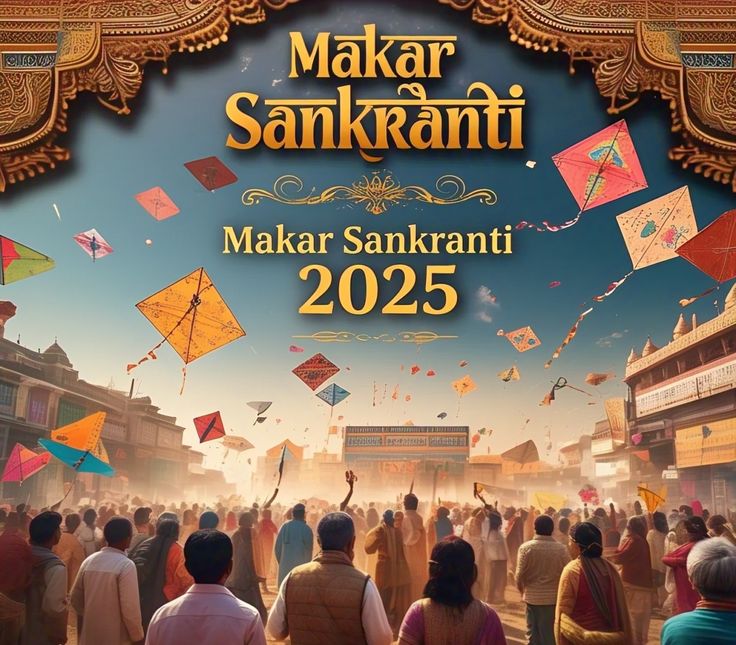Makar Sankranti: A Celebration of Harvest, Gratitude, and Renewal
Makar Sankranti, one of the most auspicious festivals in India, marks the transition of the Sun into the zodiac sign of Capricorn (Makara). Celebrated annually on January 14th (occasionally on the 15th), this festival has deep cultural, spiritual, and agricultural significance. It is a time for thanksgiving, community bonding, and the celebration of new beginnings.

What is Makar Sankranti?
The name “Makar Sankranti” comes from two Sanskrit words:
• Makar meaning Capricorn,
• Sankranti meaning movement or transition.
This festival signifies the Sun’s northward movement (known as Uttarayana), marking longer and warmer days. It is a celestial event that heralds the end of winter and the beginning of the harvest season. For farmers, this is a time of great joy as they reap the fruits of their hard work.
Makar Sankranti is unique because it is based on the solar calendar, unlike most Hindu festivals, which follow the lunar calendar. This ensures that it falls on the same date every year, with minor adjustments.
Why Do People Celebrate Makar Sankranti?
1. Harvest Festival
Makar Sankranti is primarily a harvest festival. It is a day to express gratitude to the Sun God (Surya Dev) for a bountiful harvest and to Mother Earth for her fertility. Crops like rice, sugarcane, and sesame are harvested during this season, making it a time of abundance and prosperity.
2. Spiritual Significance
In Hindu mythology, Makar Sankranti is believed to be the day when the Sun visits the home of his son, Shani (Saturn). This symbolic meeting signifies unity, forgiveness, and new beginnings. It is also believed that taking a holy dip in sacred rivers like the Ganga, Yamuna, Godavari, or Kaveri during Makar Sankranti can cleanse one’s sins and bring spiritual merit.
3. Transition to Positive Energy
The festival symbolizes the shift from darkness to light, negativity to positivity, and ignorance to wisdom. It is considered an auspicious time to start new ventures, make resolutions, and embrace hope for the year ahead.
Regional Celebrations Across India
Makar Sankranti is celebrated with unique traditions across India, showcasing the country’s vibrant diversity.
North India:
• Punjab: Celebrated as Lohri the night before Makar Sankranti, it includes bonfires, folk songs, and dances.
• Uttar Pradesh and Bihar: Known as Khichdi, people prepare and share khichdi made of rice and lentils as a symbol of unity.
West India:
• Maharashtra: People exchange tilgul (sesame and jaggery sweets) with the phrase “Tilgul ghya, god god bola” (Take tilgul and speak sweetly).
• Gujarat: Known for its grand kite festival, the sky is filled with colorful kites as people celebrate joy and freedom.
South India:
• Tamil Nadu: Celebrated as Pongal, it is a four-day festival of thanksgiving where people cook a dish named Pongal, symbolizing abundance.
• Karnataka and Andhra Pradesh: Families exchange gifts and prepare special delicacies like sesame laddoos.
East India:
• West Bengal: Celebrated as Poush Sankranti, people prepare sweets like pithe and payesh.
• Assam: Known as Magh Bihu, the festival features community feasts, bonfires, and traditional games.
Traditional Customs and Practices
• Kite Flying: A hallmark of the festival in Gujarat and parts of North India, kite flying represents cutting away negativity and embracing freedom and joy.
• Bonfires and Feasting: In Punjab, the lighting of bonfires symbolizes the end of winter, accompanied by traditional music and dance.
• Sesame and Jaggery: Across India, sweets made of sesame seeds (til) and jaggery are shared, symbolizing warmth, friendship, and goodwill.
• Charity: Donating food, clothes, or money to the needy is an integral part of Makar Sankranti, emphasizing generosity and compassion.
The Universal Message of Makar Sankranti
Makar Sankranti is more than just a harvest festival. It is a time to pause, reflect, and realign ourselves with the rhythms of nature and the universe. It teaches us to:
• Be grateful for life’s blessings.
• Embrace change and positivity.
• Strengthen bonds of love and unity.
As kites soar high in the sky and the aroma of traditional delicacies fills the air, Makar Sankranti reminds us of the joy that comes from sharing, celebrating, and staying connected to our roots.
Wishing you and your loved ones a joyful Makar Sankranti!
Makar Sankranti: A Celebration of Harvest, Gratitude, and Renewal